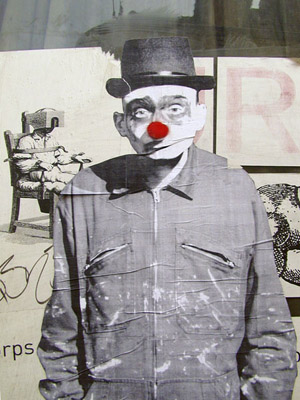
I don’t know who this chap is, but his picture was all over the place in Lille. I don’t like graffiti, but I do like collections of affiches like these. They seem to me to be quintissentially European. Here are some more.
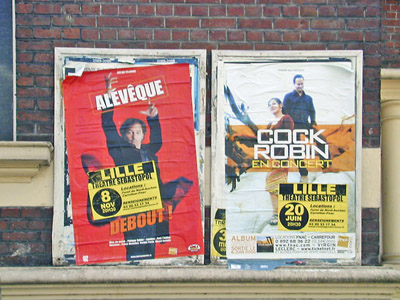
.
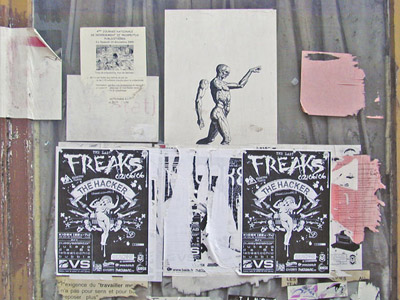

I don’t know who this chap is, but his picture was all over the place in Lille. I don’t like graffiti, but I do like collections of affiches like these. They seem to me to be quintissentially European. Here are some more.

.

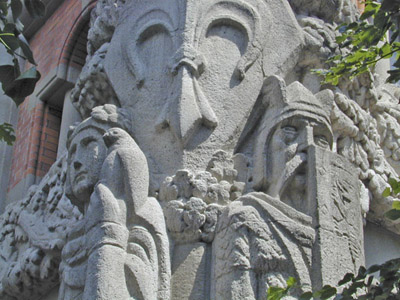
Here are the patron giants of Lille, Lydéric and Phinaert, supporting the tower of the Hôtel de Ville. According to legend—and I hope Elisabeth and MLL will put me right if I haven’t got the facts straight—in the year 620, a prince named Salvaert, fleeing an insurrection with his pregnant wife Ermengaert, was ambushed by Phinaert, a bandit lord. Salvaert was killed, but Ermengaert escaped and was taken in by a hermit. She gave birth to a son, Lydéric. When Lydéric was 20, he sought out Phinaert, challenged him to a duel, and defeated him. The King of France gave Phinaert’s lands to Lydéric, who founded the city of Lille.
There is apparently a wonderful view of the city from the tower, but it wasn’t open the day we were there. We had to content ourselves with looking around inside, where we found two more huge effigies of Lydéric and Phinaert in the auditorium.
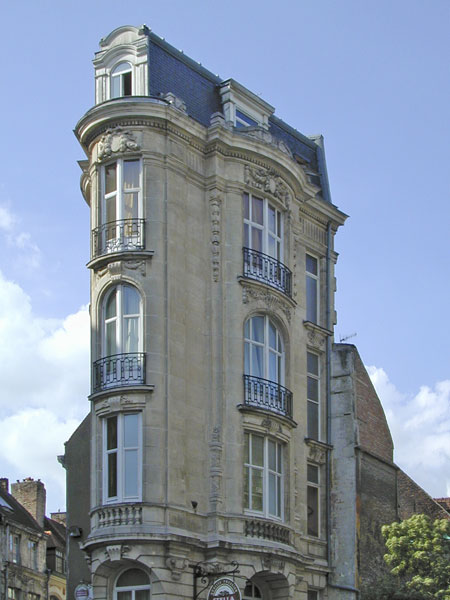
This building in Lille reminded me of the Flatiron Building in New York City, famously photographed in 1903 by Alfred Stieglitz.
I wonder if Elisabeth or MLL knows anything about this building. I would love to see one of the apartments (I assume it’s an apartment building). I imagine them as very elegant.
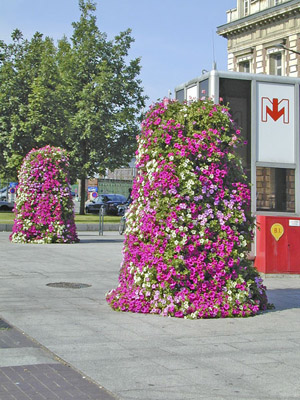
I have never seen anything like these wonderful petunia pillars before. They are in Roubaix, which is 20-minutes or so away from the center of Lille on the excellent automated métro. Roubaix was an important textile manufacturing town in the 15th to 19th centuries
But the main reason to go there today is to visit La Piscine.

Originally an Art Deco swimming pool, it is now the Musée d’Art et d’Industrie. The old pool is a gallery of 19th and 20th century sculpture. The tiled edge of the pool is still visible behind the statues. The stretch of water in the middle is about three inches deep.
The old shower stalls and changing rooms have been turned into display cases for—among other things—the splendid displays of textiles and related items, and the wings that made up the municipal bath house and once contained bath tubs now house the fine arts collection.
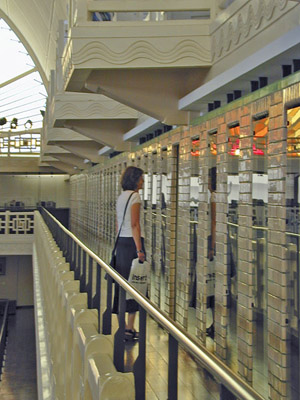
To remind you of this wonderful building’s past, every so often, you hear a couple of minutes of taped shrieking and splashing.
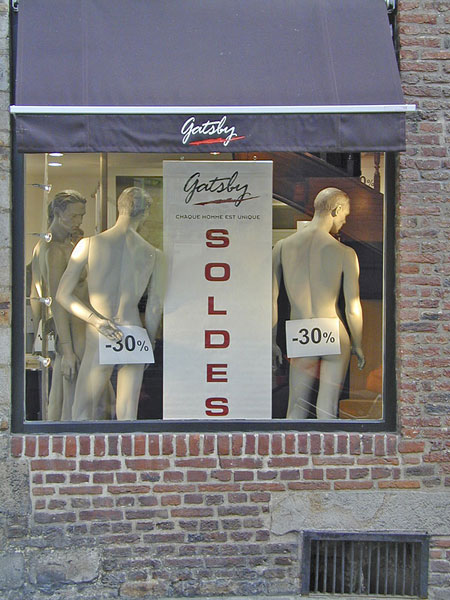
I was a teenager when I first started to travel out of England, where I grew up. I didn’t care about traditional souvenirs; one of the coolest things for me was to come home with a tube of toothpaste of an unfamiliar brand that said it was “dentifrice” or a bar of soap that called itself “sapone.” The ultimate in cool was using foreign, and therefore exotic, products.
Now the same stores and the same products are everywhere, and I find it very disappointing. It’s not that anyone makes me shop at Tesco in Prague or eat at McDo (God forbid!) in Paris or buy Colgate toothpaste in Venice; it’s that I don’t want it to be even a possibility.
Sales were going on while my friends and I were in Lille (carefully avoiding Euralille for fear of finding a WalMart), and I’m happy to say that the exotic kicked in for me because the window displays were far more creative and daring than anything you’d be likely to see in the United States. This one was my favorite: At Gatsby’s “chaque homme est unique.”
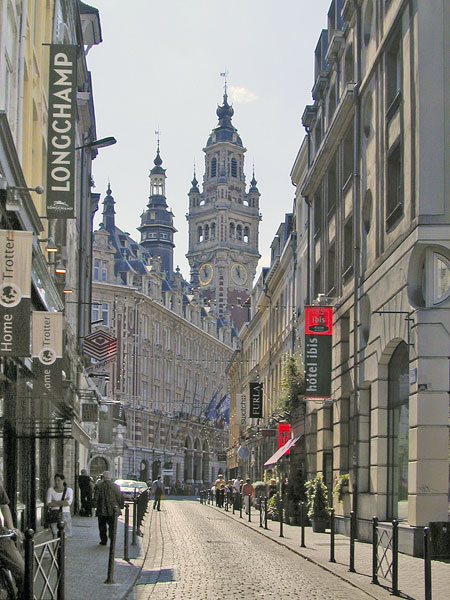
The exquisite 76m neo-Flemish belfry of the Lille Chambre de Commerce is seen towering above the buildings on this street. The Chambre was designed by Louis Marie Cordonnier and blends well with the style of such nearby buildings as the Vieille Bourse.
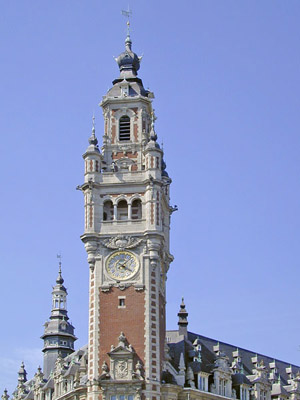
Below is the boxy Credit Lyonnaise tower, conceived by the architect Christian de Portzamparc as a block in the sky signalling renewal. It stands near the Gare Lille-Europe and the Euralille Centre.
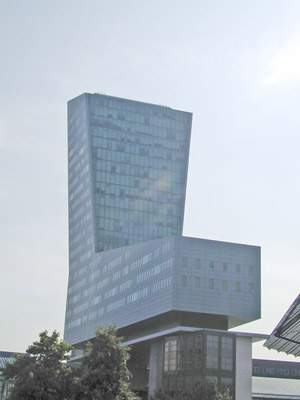
Two such different buildings, both representing commerce, both built in the 20th century, and both—to me—with their own distinctive appeal.
This supporter of Germany was certainly in the minority in Lille.
The staff of the little restaurant where my friends and I ate the night of the World Cup semifinal had hooked up a small television so that they could catch glimpses as they worked. Our waiter kept apologizing for forgetting things, explaining that he was distracted. We certainly didn’t care; we were on holiday and had all the time in the world. Besides, even though none of the three of us cares a bit about soccer, we were caught up in the moment and were rooting for Les Bleus right along with him. When France won, Lille erupted. Until well after 2 PM, people drove round honking horns and yelling.
The German flag continued to flutter from the window for a couple of days after the match—sadly but defiantly, I thought, as I watched it from my hotel room. I’m not good at competitive stuff. I’d like it best if everyone could win.
Save for the ever-present crottes on the sidewalk, Lille is a clean city. However, I was surprised at the amount of graffiti …
often in seemingly impossible places. This wasn’t the only dome I saw adorned with paint.
How do the perpetrators (it must have taken more than one person) do it? It requires equipment like ropes and ladders to be carried into the building and then onto the roof. It requires daring (or stupidity, depending on your point of view). And it requires time because it’s not the work of a couple of quick squirts of a spray can. How do they get away with it? During the daytime they would be seen. At night they’d need strong lights—more equipment to haul up there.
But most of all, why does the city of Lille allow graffiti to remain, disfiguring beautiful and sometimes historic buildings?
We stepped into the courtyard and there in the cloisters was a book market. It’s there every weekday. What a pleasure to get out of the hot sun and join others browsing among the stalls of antiquarian and used books and watching the chess games.
I wasn’t in Lille on a Sunday, but apparently that’s when there are impromptu tea dances in the courtyard. It would have been too hot for much dancing when I was there.
Thanks to Marie of Alexandria Daily Photo for her four cliffhanger posts this week, which inspired me to make this a two-part post.
This is one of the four doorways into the old Bourse de Commerce, a restored Flemish Renaissance building consisting of 24 17th century houses around a cloistered courtyard. Lions of Flanders adorn the doorways.
Step through one of the doorways into the courtyard, and you will find floral and fruit motifs and symbols of the original guilds that traded here in the 17th century decorating the cloisters. You’ll also find … well, I’ll tell you that tomorrow.
All the houses on rue Fleurus look pretty much the same. And then you come to number 14, the Maison Coilliot.
The original owner, M. Coilliot, wanted something different, so he commissioned Hector Guimard, the architect responsible for many of the Paris Métro entrances, to redesign his house. Guimard combined volcanic rock, cast iron, and Coilliot’s own ceramics to create this wonderful Art Nouveau facade with its swirling decorative motifs. It’s still a private residence, so you can’t see the interior. Even so, it’s well worth a visit if you’re in Lille.
On my recent trip home to Europe, I spent several days in London (as you’ve seen from previous posts), staying with longtime dear friends and every afternoon visiting my 93 year-old aunt. Then my friends and I left for a few days in France.
Leave central London by rail on the Eurostar, and in less time than it takes some people in the Washington area to drive to work every day, you can be on French soil. Waterloo Station to Lille-Europe Gare (seen here) takes 1 hour and 40 minutes.
Lille is in northern France near the border with Belgium and was formerly a major textile manufacturing center. It’s now an important part of the European TGV (train à grande vitesse) network. Lille’s best-known native son is probably the late French president, Charles de Gaulle.
The city has much of interest, including an art museum that is widely reputed to be second in France only to the Louvre, and the first driverless metro system in the world, which was also the longest until the opening of the Vancouver Sky Train in 2002.
When you leave Lille-Europe Gare, one of the first things you see is this sculpture. The serpentine stems and predatory blossoms made me uneasy. The flowers had, for me, the repulsive fascination of Venus Flytrap plants, and the purple tulip on the left reminded me of Audrey Jr., the impossible-to-stop plant in Little Shop of Horrors.
The sculpture is called Tulips of Shangri-la and is the work of the Japanese artist Yayoi Kusama. Anyone who knows the artist would recognize the work, if only from the trademark polka dots. I haven’t consciously heard of her and didn’t recognize it, but I think I may have seen other examples of her work because there was something familiar about it. I’ve since learned that she has suffered hallucinations and suicidal tendencies since childhood and now, after many years in New York, she chooses to live in a psychiatric hospital in Tokyo and work from her nearby studio.
Something I love in London (and miss in Washington, D.C.) is buying my fruits and vegetables from a greengrocer whose stall is on the sidewalk like this one in Turnham Green in west London. This man ambled into my shot and appears to be pondering the contents of the stall. I hope he’s thinking that replacing fish and chips and bangers and mash with some of the huge variety of fresh produce available here would help his waistline.
The London Eye is on my list of things to do sometime when I visit my hometown. The day I took this picture would have been perfect for a clear view from 135 metres, but of course everyone else had the same idea. It’s efficiently managed—rather like a ski lift, it’s a perpetual process of replacing the group returning with the group departing—but it still would have taken up more time than I wanted to give up on this occasion. There’s an official site if you’re interested in booking advance tickets online (and saving 10 percent), but for interesting information, Wikipedia is a better bet.